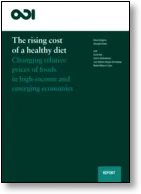The share of the population that is overweight or obese is increasing, especially in the emerging economies of the developing world. This report explores policies to combat obesity. Specifically, it analyses the effects of relative price changes between different types of foods on consumer behaviour in high-income and emerging economies (Brazil, China, Republic of Korea and Mexico). The researchers look into the causes of increasing obesity and changes to the retail prices of foods and ask if healthy eating is becoming a luxury in emerging markets, as has been the trend in high-income countries.

Given the strong links between healthy and sustainable diets (see for example the FCRN discussion paper on What is a sustainable healthy diet?) the trend of rising prices for healthy foods will likely have implications for our ability to shift to more sustainable diets globally.
 This infographic has been produced based on the ODI report:
This infographic has been produced based on the ODI report:
Abstract
Everywhere in the world the share of the overweight and obese population is increasing, no more so than in the emerging economies of the developing world. No country has stemmed the increase. Effective policies to combat obesity have yet to be proved, if only because no country has yet tested a sufficiently comprehensive set of policies. Understanding the causes of increasing obesity matters. The rise of obesity corresponds to multiple factors, but one that is imperfectly understood is changing relative prices of different foods, arising from technical advances in both growing food as well as in processing and marketing it. If people are increasingly eating foods dense in nutrients, and especially processed foods, is that because they are influenced by cultural stimuli such as media and advertising; or is it because these foods have become relatively cheap compared to unprocessed food? Foods that become cheaper compared to others are likely to be consumed more. So are high calorie diets becoming cheaper compared to more healthy options? This has been the trend in high-income countries over the last 30 years. But what has been happening to the prices of different foods in some of the rapidly-growing emerging economies where incomes have risen notably in the last 20 years? In this report we investigate changes to the retail prices of foods in Brazil, China, Republic of Korea and Mexico. We also look at the political appetite to contemplate taxing foods and whether taxes and subsidies could encourage more consumption of healthy foods and less of unhealthy items.
Citation
Wiggins, S., Keats, S., Han, E., Shimokawa, S., Vargas Hernández, J. A., Moreira Claro, R., 2015. The rising cost of a healthy diet: changing relative prices of foods in high-income and emerging economies, Overseas Development Institute.
Read the full report here. See also an illustration, graphs and a video accompanying the report on the ODI website here. See also this article from Food Navigator, which discusses the report.
In a related article in New York Times, it is argued that we need to expand our areas of public policy intervention to shift diets in a more healthy direction, and not only focus on prices and accessibility.




Comments (0)